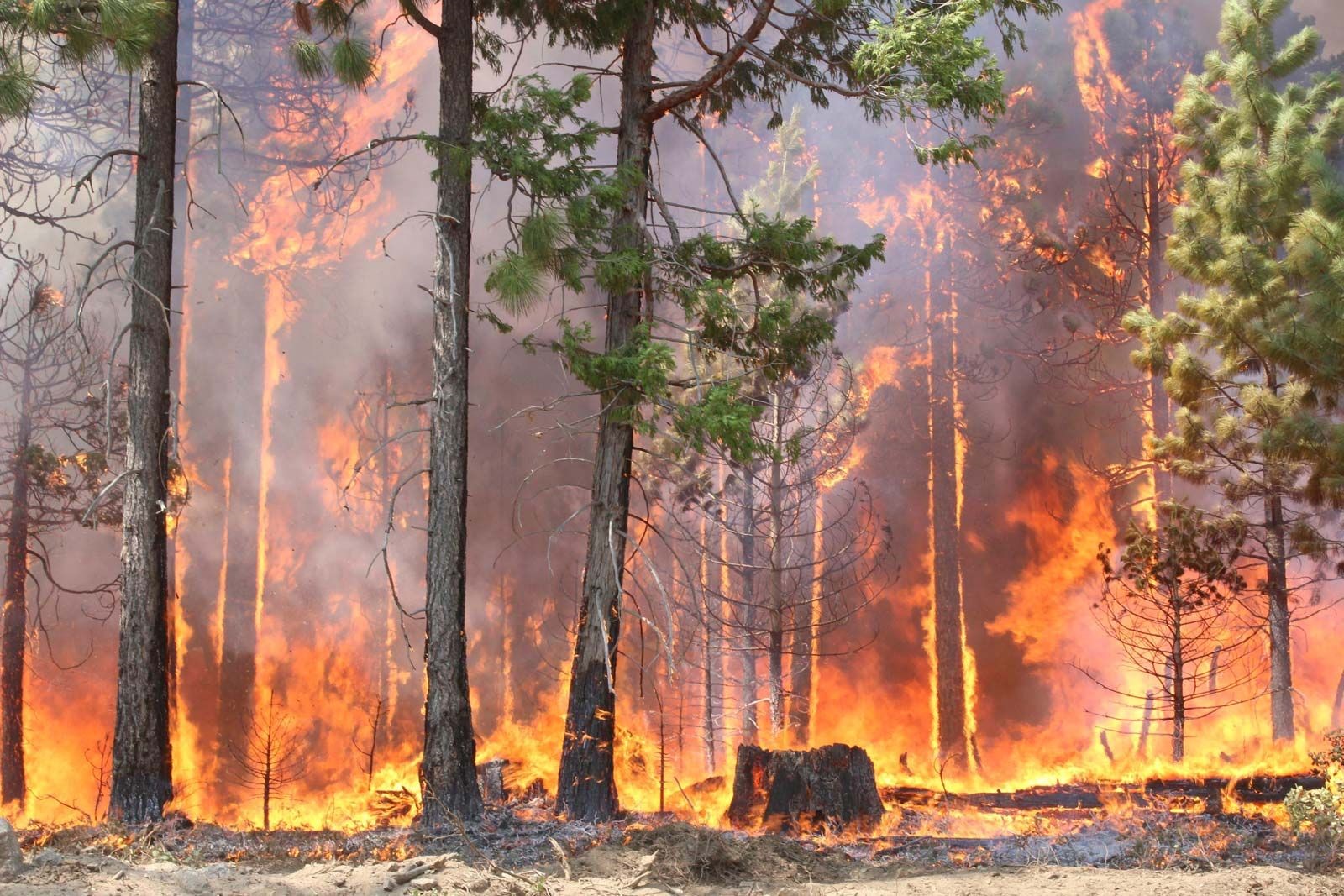
Disclaimer: Copyright infringement not intended.
Context
- A forest department probe is learnt to have concluded that the fires were largely triggered by natural causes, confirming the central government’s submission to Parliament last month that a “prolonged dry spell, unprecedented high temperatures, and low humidity” caused “sporadic” fire incidents in the state.
Details
- Opposition parties and environmentalists have alleged the fires were “man-made”, deliberately lit by vested interests.
- There is a systematic game plan to destroy green cover with an eye on land to be used for real estate.
What is the connection between weather and fires?
- Very little rain in Goa since October last year, along with heat-wave-like conditions and low humidity, created conditions that were ripe for forest fires.
- Once the carpet of dry leaves on the hilltops caught fire, the flames were fanned and spread by high winds.
- Of late, incidents of forest fires in Goa during the summer have been more in the years following those of poor monsoon rain.
- A similar pattern has been seen in Karnataka as well.
- Some fires near cashew plantations may have been caused by owners lighting fires.
- Minor surface fires that burn undergrowth and dead organic matter on the forest floor are common due to the slash-and-burn techniques used by villagers to clear grazing land for cattle.
- Cashew farmers often start minor constrained fires to clear weeds and reduce undergrowth.
- There have been instances where fires have been traced back to the stray beedi or cigarette.
.jpeg)
Why are environmentalists worried?
- They fear that vested interests may have lit fires to reduce forest density and clear land for real estate development.
Rising incidents of forest fires in India
Managing Forest Fires in a Changing Climate (Council of Energy, Environment and Water)
- An April 2022 study, it has noted a tenfold increase in forest fires over the past two decades.
- More than 62% of Indian states are prone to high-intensity forest fires.
- Andhra Pradesh, Odisha, Maharashtra, Madhya Pradesh, Chhattisgarh, Uttarakhand, Telangana, and the Northeastern states are most prone to forest fires, the study found.
- Mizoram has seen the highest incidence of forest fires over the last two decades, and 95% of its districts are forest fire hotspots.
ISFR 2021
- The ISFR 2021 estimates that more than 36% of the country’s forest cover is prone to frequent forest fires, 6% is ‘very highly’ fire-prone, and almost 4% is ‘extremely’ prone.
- The forest fire season normally extends from November to June, and the majority of fires are caused by man-made factors, the report says.
A report by the Ministry of Environment, Forest and Climate Change for 2020-21
- It identified western Maharashtra, southern Chhattisgarh, parts of Telangana and Andhra Pradesh, and central Odisha as becoming ‘extremely prone’ to forest fires.
- An FSI study based on the spatial analysis of forest fires points during the period 2004-21 has found that nearly 10.66% area under forests in India is ‘extremely’ to ‘very highly’ fire-prone.
What is the importance of forests?
- Forests are crucial to life; they sustain biodiversity and provide endless incalculable products and important ecosystem resources such as storage of carbon, flood & landslide control, clean supply of water, medicines, and crops.
Data related to forests
- The global forest comprises 4.06 billion hectares of the area which is equivalent to 31% of the total land
- Approximately 6 billion people across the world depend on these forests, including 300 million people living within them.
- Between the years 2000 to 2010, a decline of the forest area by about 5.2 million hectares per year (0.1% of the total forest area) has been discerned.

Forest fire in India
- India occupies just only 5% of the global geographical area, 1.8% of the overall forest area and it supports 16% of the total human population.
- Out of the 647 districts in India, nearly 380-445 districts encountered fires every year from 2003 to 2016 (World Bank, 2018).
Distribution
- Nearly 4% of the forest area in the country is extremely vulnerable to fire, while more than 6% is found to be highly vulnerable to fire.
- With respect to the forest area and the fire ecology variation therein, India can be divided into four geographical clusters viz. North Himalayan, North-Eastern, Southern, and Central.
- These clusters encompass ~ 90% of the total forest cover in India and encountered 98% of the total fire points detected in India from the year 2003-16.
- The North-Eastern cluster accounts for the maximum forest cover of 36% and the number of fire detections (40%), however, the maximum forest burnt area (56%) is in the Central cluster, which suggests that the Central cluster is the most vulnerable region in India.
Central cluster
- The Central cluster encompasses states like Madhya Pradesh and some districts of Chhattisgarh and Rajasthan.
- With a subtropical climate, this cluster encounters average rainfall from 800 mm to 1,800 mm with the mean annual temperature varying between 22°C to 25°C.
- It mainly consists of forest species such as Tectona grandis, Shorea robusta, Lagerstroemia parviflora, and fires therein are caused by slashing and burning agricultural practices that help to collect non-timber forest products.
North-eastern cluster
- The maximum number of fires detected (55%) were in the North-Eastern cluster which also accounts for the maximum forest cover of 36%.
- In this cluster, fires tend to concentrate in a smaller area that is subject to repeated burns.
- Fires in North-Eastern cluster, occur mainly from slash and burn agriculture.
- Coniferous forests in the North Himalayan cluster region comprise species such as fir, spruce, and pine. Due to the harsh conditions, tree growth in this cluster is minimal.
North Himalayan cluster
- The North Himalayan cluster is spread over states such as Kashmir, Uttarakhand, and Himachal Pradesh.
- Important species include Shorea robusta, Pinus roxburghii, Quercus leucotrichophora, and Mallotus philippinensis.
- Fire is used as a tool by indigenous communities of the area to clear grass that contributes to forest regeneration.
South cluster
- Southern Cluster consists of states like Karnataka, Kerala, Tamil Nadu, Andhra Pradesh, Telangana, and some districts of Maharashtra.
- This cluster encounters average rainfall from 1000 mm to 1,800 mm, while the mean annual temperature varies between 20°C to 26°C.
- Important species include Dipterocarpus indicus and Vateria indica.
- Fires in Southern clusters are more expansive and occur due to human accidents, for management of forest, and due to slash and burn practices.
Impact of forest fires
Impact on biodiversity
- Wildfires can have devastating effects on biodiversity by destroying trees, ecosystems, and food supplies and by increasing the resulting susceptibility to predation of surviving animals
- Spatial factors such as the location of a plant’s dormant bud, the sub-surface distribution of reproductive structures, and the depths below the surface from which new shoots emerge depict an individual plant’s growth behavior post-fire.
- Depending on the intensity and return period, fires can be beneficial or harmful.
Impact on soil properties
- Forest fires have a significant impact on post-fire forest composition and structure of soil.
- It can affect many physical and chemical soil properties including “loss of organic soil and structure, reduced porosity, and increased pH”.
- Indirect consequences, include increased water repellence resulting in reduced penetration and increased runoff, which leads to increased
- Fires of higher intensity can considerably deplete the soil and alienate it of nutrients and organic matter.
Impact on climate change
- Climate change has been observed to be on the rise due to the dominant anthropogenic activities that have been exceeding the bounds of natural variability.
- Forest fire and climate change possess a feedback
- Human-instigated climate change has attempted to put more prominent pressure on numerous forest species and has weakened their ability to withstand fires.
Economic impact of forest fires
- Forestry is the second-largest land use after agriculture and accounts for about 1.5 % of the nation’s GDP”.
- With 65 million people identified as tribal groups, they rely on the collection of non-wood forest products from forest areas for their livelihoods and are directly affected by forest fire.
- The economic losses associated with forest fires can be much greater for smallholders than for large holders, because they rely on the forest for a wide range of services and uses.

Fire management practices in India
Detection practices
- Globally, various wireless sensors, satellite systems, and neural network-based techniques are being employed in order to detect or manage forest fires.
- However, in India, currently, fires are detected using satellites and ground-based measurements.
- In India, active forest fire detection systems rely on the MODIS (Moderate Resolution Imaging Spectroradiometer) instrument and the Visible Infrared Imaging Radiometer Suite (VIIRS) for satellite-based hotspot observation.
Prevention Strategies
- Formulation of National Forest Policy in 1988, The National Master Plan for Forest Fire Control, and Guidelines in 2018 are some of the key initiatives that the Government of India has taken to manage the fire.
- Common methods for prevention of fire used in India include - fire line clearance and controlled burning to limit fuel loads, silvicultural practices such as selective thinning and fire-adapted tree species planting in fire-prone areas, early warning, and fire hazard rating systems.
- The implementation of Joint Forest Management (JFM) village level committees was another significant step in the micro-level management of forest fires in India.
Challenges
- The knowledge in systematic forest fire control is limited to the short term.
- There are weaknesses in the evaluation, ranging from fire detection to the coordination of preventive steps.
Way Forward
- At this time, the need to establish an adaptive management plan is critical.
- Sector-wise, with short- and long-term visions, clear points are suggested for the implementation of a holistic fire prevention plan in the light of climate
- Some of them include mitigation measures to minimize the uncertainty in baseline data, strengthen present fire-fighting programs, developing precautionary measures, integrating institutional efforts, publicity, extension, and training, legal measures, and funding of more programs aimed to improve the current status.
MUST READ ARTICLES:
Wild Fires: https://www.iasgyan.in/daily-current-affairs/wildfires-25
|
PRACTICE QUESTION
Q) Forest fire and climate change possess a feedback effect. Discuss. (150 words)
|

https://indianexpress.com/article/explained/explained-climate/goa-forest-fires-in-march-2023-explained-8596719/




